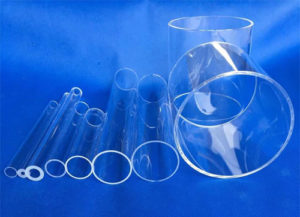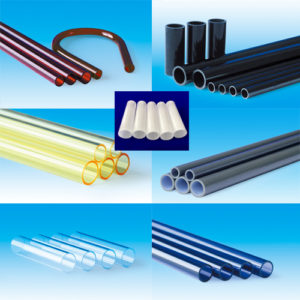Quality description:
The SiO2 purity of fused quartz tube made of quartz sand is ≥ 99.98%, which working temperature for a long time is around 1100c (after annealing or dehydroxylation: 1200C). And the melting point is around 1730c. The SiO2 purity of fused quartz tube made of high-purity quartz sand is ≥ 99.995%, Which working temperature for a long time is around 1200C (after annealing or dehydroxylation: 1300C). In actual use, the difference between the two kinds of pipes is not very obvious, but the cost gap will be large. In general, if there is no specific requirement, we will decide which material to use according to different use purposes.
Through obsersation of fused quartz tube’s surface, it can be marked as be superior products if no bubble, no ray, and no defect. Qualified products if only 1-2 small bubbles.
In terms of discoloration, fused quartz tube can be divided into dehydroxylation discoloration that it can become black, brown and yellow at high temperature. Usually, this kind of quartz tube is due to the fact that the material is relatively high in impurity such as blackening is generally high in iron. No discoloration at high temperature is mean that it is high in purity and durable.
Main functions of fused quartz tube: high temperature resistance, high UV transmittance, acid and alkali resistant and anticorrosion(except dehydrofluoric acid).
Application fields: UV sterilization lamp, chemical industry, scientific research, semiconductor, high frequency furnace, liquid level meter, etc
Specification:
Fused Quartz Glass Tubes are available from OD2mm to OD500mm. The wall thickness ranges from 0.5mm to 10 mm. Larger diameter, Thicker the wall. Generally, the length of common is 1240mm. And the large diameter is generally between 200mm and 300mm.
Distinguish:
Ⅰ. Fused Quartz Glass Tube are distinguished by color as follows:
Transparent and colorless, milky white (opaque), red, yellow, black, gray, purple and so on. Quartz tubes of different colors are made of fused quartz because different processes produce out different colors. Common transparent quartz tubes have better physical and chemical properties. Our company mainly supplies two types of fused quartz tubes: transparent and opaque. The specifications and sizes of transparent or clear fused quartz tubes are more, but the opaque ones are less.
Ⅱ. According to use, Fused Quartz Glass Tube can be divided into:
1. UV sleeve
2. Thick wall quartz tube for position meter(boiler tube)
3. Quartz tube for medium and high frequency furnace
4. Quartz tube for tubular furnace
5. Quartz tube for ozone generator (high ozone quartz tube, no ozone quartz tube, UV filter quartz tube)
The Application Fields of Quartz Glass Tubes
- Definition and manufacturing process of quartz glass tube
A quartz glass tube is a tubular material composed primarily of quartz glass. The material of quartz glass is distinguished by its high transparency, high thermal resistance, and low linear expansion coefficient, which renders it a highly versatile material with a wide range of applications in optics, chemistry, electronics, and semiconductor technology, etc. The manufacturing process of quartz glass tubes encompasses forming by melting, forming by drawing, forming by processing, and other techniques.
- Application of quartz glass tubesin optical field
Quartz glass tubes are a common material in the field of optics, particularly in the production of optical instruments and other optical processes. The material possesses several advantageous properties, including high transmittance, low dispersion, high thermal resistance and a low thermal expansion coefficient. Consequently, it can be employed in the fabrication of a range of optical components, including lenses, prisms, and windows. Moreover, it is employed extensively in the domains of laser devices, optical communication, and thin film technology.
- Application of quartz glass tubesin the field of chemistry
Quartz glass tubes are also of significant utility in the field of chemistry. Due to its corrosion resistance and high temperature properties, it can be employed in the fabrication of chemical reactors, natural gas liquefaction units, chemical sensors and liquid level meters. At the same time, the quartz glass tube is conducive to the observation of the chemical reaction process, thereby facilitating improvements in reaction efficiency and reductions in the emission of pollutants.
- Application of quartz glass tubesin electronic field
Quartz glass tubes are employed extensively in the field of electronics. The material possesses the characteristics of high transparency, low dielectric loss, high mechanical strength and high temperature resistance, and can be utilized in the fabrication of electronic chips, light-emitting diodes, semiconductor devices and solar panels. Additionally, quartz glass tubes are employed as reaction and heat treatment chambers in the manufacturing of electronics.
- Application of quartz glass tubesin other fields
In addition to the optical, chemical and electronic fields, quartz glass tubes have a number of distinctive applications in other fields. For example, in the biological field, quartz glass tubes can be employed in the fabrication of protein purification columns and nucleic acid extraction columns. Similarly, in the field of food manufacturing, quartz glass tubes can be utilized in the production of high-temperature sterilization devices and heating equipment.
In summary, quartz glass tube is a kind of high-quality material with a broad range of potential applications. It possesses distinctive applications and advantages in the fields of optics, chemistry, electronics and semiconductors. As a consequence of the ongoing advancement of science and technology, coupled with the continual expansion of the range of applications, the future prospects for quartz glass tubes are set to become increasingly diverse and extensive.
For prompt quotation, please contact us at below form.
Application:
Chemical Industries
Electric Light Source
Laboratories
Medical equipment
Metallurgy
Optical
Photovoltaic
Photo communications
Research
Schools
Semiconductor
Solar


